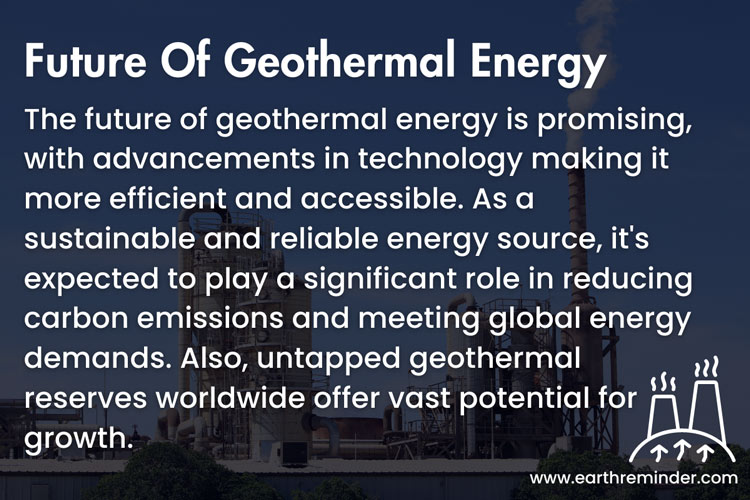The Future Of Geothermal Energy
Geothermal energy is a sustainable and environmentally friendly source of power that harnesses the Earth’s natural heat. As the world struggles with climate change, geothermal energy is becoming increasingly popular. Here, we will explore the potential future of geothermal energy and how it may shape our energy sector going forward.
Table of Contents
What is Geothermal Energy?
Deep inside our planet, it’s really hot. We can use that heat to make electricity or warm our homes. At its core, geothermal energy is the heat that originates from the Earth’s depths. This heat can be captured and used in two main ways:
- Direct Use: For heating buildings, growing plants in greenhouses, drying crops, etc.
- Power Generation: By converting hot water or steam from the Earth’s crust into electricity.
The Current State of Geothermal Energy
The use of geothermal energy has been growing steadily despite its small share of the global energy mix. It’s being harnessed effectively in countries like Iceland, New Zealand, and the USA.
As industries move towards more sustainable and economical energy sources, geothermal power is becoming more popular. The US Department of Energy says geothermal energy could be producing 90 gigawatts by 2050, up from 3.7 gigawatts currently. The U.S. Department of Energy invested $75 million in Enhanced Geothermal Systems pilot projects in February 2023 as an indication of its commitment to growing the geothermal industry.
Let’s look at a few advantages:
Continuous Power Supply
Geothermal energy is consistent and doesn’t depend on weather conditions, unlike solar or wind energy. Geothermal energy still has this benefit, and advances in energy storage technologies will likely boost its growth and reliability.
Economically Viable
Though the initial investment can be high, the long-term benefits in terms of low operation and maintenance costs make it a good investment. For example, in the United States, geothermal power plants produced about 17 billion kilowatt-hours in 2022, which accounted for 0.4% of total electricity generation. From 2023 to 2032, geothermal energy is expected to grow at a compound annual growth rate (CAGR) of 7.9%, thanks to its economic viability and global deployment of clean energy.
Environmentally Friendly
It releases very low amounts of greenhouse gases compared to fossil fuels. According to research, geothermal power plants release vastly fewer sulfur compounds that cause acid rain (97% less) and almost no carbon dioxide (99% less) compared to similar-sized fossil fuel plants. In 2022, binary geothermal technology segment valued at over USD 15 billion because of its high efficiency, minimal emissions, and compatibility with other energy sources. This technology contributes to geothermal’s environmental benefits.
Innovations in Geothermal Energy
Geothermal energy is becoming more cost-effective and efficient. Below are some innovations with respect to it:
Enhanced Geothermal Systems (EGS)
It is a promising development that engineers are working on where they are drilling deep into the earth and injecting water into hot rock formations. This process produces steam that is then used to produce electricity. EGS might be able to unlock vast expanses of land previously thought to be unsuitable for geothermal energy development. As of now, only three EGS projects are operational.
Recently, Fervo Energy announced that Project Red, an EGS initiative, generated 3.5 megawatts of clean electricity over a 30-day test period, more than any other enhanced geothermal plant on the planet. Google’s Las Vegas data center operations are going to benefit from this project.
Improved Drilling Techniques
The development of advanced drilling technologies is making it more efficient and less expensive to access deeper and hotter geothermal resources than ever before.
By using geothermal energy, Fervo plans to remove carbon dioxide (CO2) from the atmosphere and store it underground in geothermal reservoirs. It will use direct air capture (DAC) system.
Low-temperature geothermal energy involves the extraction of geothermal heat from between 150 and 200 meters below the surface, but drilling technologies are making it more efficient to access resources from deeper depths.
Hybrid Systems
It is possible to make energy production more efficient by combining geothermal energy with other renewable resources, such as solar energy, wind power, and biomass.
Adding geothermal energy to other renewable sources keeps increasing renewable energy systems’ efficiency and output. A new Fervo Energy project in southwest Utah plans to provide 400 megawatts by 2028, enough to power 300,000 homes. They’re also developing several more hybrid system sites across the western U.S.
Research indicates that these combinations can greatly enhance the power output of turbines and overall thermal efficiency, especially when used to boost the pressure of the geothermal fluid from the well.
What Is the Future of Geothermal Energy?
The future use of geothermal energy is as follows:
Wider Adoption
More and more countries and regions will be able to tap into geothermal energy in the future, especially those countries and areas with abundant geothermal resources due to technological advances and lower costs.
For example, Iceland leads the way in using geothermal energy for heating spaces. Recently, there’s been a substantial increase in producing electricity from geothermal energy. Currently, a quarter of Iceland’s entire electricity production (about 25%) comes from geothermal power plants.
Through NREL’s research, geothermal energy can be better identified, drilled more efficiently, and expanded globally. NREL’s support and Colorado’s initiative might inspire other places to explore geothermal energy.
Desalination
Since freshwater is a scarce resource in many parts of the world, geothermal energy may offer a solution to meeting the needs of desalination plants by providing them with the power they need. Desalination is a process where salt and other minerals are removed from the water to make it drinkable. Currently, only 1% of the world’s population depends on desalination for water, but by 2025 it is expected that it will be 14%.
A project like DEEPEN (for super-hot geothermal resources), for example, could significantly increase the power output of geothermal wells, affecting desalination and other energy-intensive processes.
Agriculture and Industry
Geothermal energy can be utilized in various agricultural processes like drying crops. Heat can be used to remove moisture from plants if needed. It can also be used for heating greenhouses. Plants will stay at a proper temperature all year long, preventing harsh weather damage. People who live near geothermal resources might switch to this green energy source in the future.
Integration with Energy Grids
Grids deliver electricity from producers to consumers through interconnected networks. A geothermal power plant can play a vital role in stabilizing the energy grid since they are capable of providing consistent energy when required. The FLXenabler project, for example, explores how geothermal can work with renewable energy and thermal energy storage for community-wide use.
Research and Development
Geothermal energy can be more efficient and useful with more R&D. It’s possible we’ll find new, revolutionary ways to harness Earth’s heat with more investment.
Also Read: Geothermal Energy vs Solar Energy.
Challenges to Consider
Like all the other sources of energy, there are some challenges with geothermal energy.
- Initial Costs: It can be expensive up front, especially for developing countries. For example, in Indonesia, the development of geothermal energy requires a significant investment of about US$4 million for each megawatt of power generation capacity, which is slowing its progress due to the high costs involved. In 2023, the initial cost is expected to be US$5-6 million per MW.
- Resource Depletion: Temperatures and pressure can drop in geothermal reservoirs when geothermal resources are extracted faster than they can be replenished naturally. So, it is very important to manage them responsibly.
- Environmental Concerns: Geothermal power is more environmentally friendly than fossil fuels, but it can degrade land and cause minor earthquakes. A nearby structure or road can be affected by this.
Conclusion
Geothermal energy is going to play a huge role in the future. As technology advances, climate change awareness grows, and sustainable energy sources are needed, geothermal energy seems like a good option. It’s important to harness all energy sources responsibly, so they benefit the environment and humankind.

